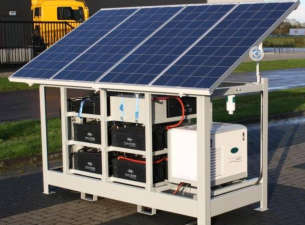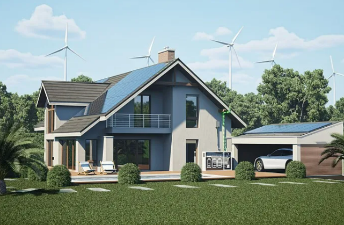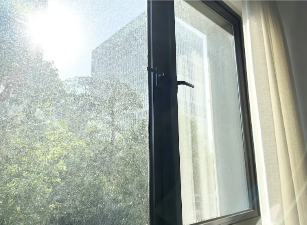How much does a home solar power generation system cost? First of all, you need to understand what a home solar power generation system is. This is very important. As long as it is a home photovoltaic system, it can be understood as an off-grid power generation system. For an off-grid photovoltaic power generation system, its core is the battery. Because after solar power generation, it needs to be stored in the battery first to ensure uninterrupted and continuous power supply, so as to meet the normal power consumption of the family.


How much does a home solar power generation system cost? First of all, you need to understand what a home solar power generation system is. This is very important. As long as it is a home photovoltaic system, it can be understood as an off-grid power generation system. For an off-grid photovoltaic power generation system, its core is the battery. Because after solar power generation, it needs to be stored in the battery first to ensure uninterrupted and continuous power supply, so as to meet the normal power consumption of the family.

The cost of solar panels ranges anywhere from $$20,548 to $$30,666, with the average 6kW solar system falling around $18,604. It’s important to note that these prices are before incentives and tax credits are applied. We found that solar panel prices vary based on where you live, the size of the system, the type of solar panels and more. With so many factors that go into the final price tag of your solar panels, knowing exactly where you might incur costs can help you budget for solar panels so that you can see the biggest energy savings.
We’ve broken down how much solar panels cost by analyzing a variety of cost databases and retailers to help you get started.
operating principle
During the day, under light conditions, the solar cell module generates a certain electromotive force, and forms a solar cell array through the series and parallel of the module, so that the array voltage meets the requirements of the input voltage of the system. Then the battery is charged by the charge and discharge controller, and the electric energy converted from the light energy is stored. At night, the battery pack provides input power to the inverter. Through the function of the inverter, the direct current is converted into alternating current, which is transmitted to the distribution cabinet, and the power is supplied by the switching function of the distribution cabinet. The discharge of the battery pack is controlled by the controller to ensure the normal use of the battery. The photovoltaic power station system should also be limited load protection and lightning protection devices to protect the over-load operation of the system equipment and avoid lightning strikes, and maintain the safe use of the system equipment.
Cost of Solar Panels by Type
When you are budgeting for a solar panel system, you are likely to come across three types of solar panels. Each one comes with its own price tag, so consider the following price differences before you choose.
Monocrystalline Solar Panels
Single-crystal solar panels, which cost between $1 and $1.50 per watt on average, are often the most popular choice. As the name suggests, a single crystal cell is made of a single silicon crystal. These lab-grown crystals , known as ingots , are cut into thin octagonal discs and neatly attached to panels for maximum efficiency. This greater efficiency comes at a price, as most single-crystal solar panels cost more to buy and install than comparable products.
Polycrystalline Solar Panels
The average cost of a polycrystalline solar panel is $0.90 to $1.50 per watt. Both polycrystalline and single-crystal solar panels are photovoltaic (PV) solar panels. They convert sunlight into electricity. However, unlike single-crystal cells, polycrystalline cells are cut from broken silicon crystals into a circular shape. This shortcut makes the product cheaper and faster to produce, but also less efficient.
Thin-Film Solar Panels
Thin-film solar panels cost between $0.50 and $1.50 per watt, at the lowest end of the solar panel price range. These solar panels also utilize photovoltaic materials. Only most thin-film cells use amorphous silicon, which is not a crystal. Thin-film solar panels are cheaper to produce and use off-the-shelf materials that are better for the environment.
Solar panels tend to be less efficient and therefore require more space to produce the same amount of energy. They also last only 10 to 20 years, 10 to 15 years less than photovoltaic panels. Still, if you're on the road, we believe thin film solar panels are a good fit for an RV because of its lightweight nature.

advantage
1, solar energy is inexhaustible, and the solar radiation received by the earth's surface can meet the global energy demand 10,000 times. As long as four percent of the world's deserts are installed with solar photovoltaic systems, the electricity generated can meet the needs of the world. Solar power is safe and reliable, and will not suffer from energy crises or fuel market instability;
2, solar energy can be anywhere, can be nearby power supply, do not have to long-distance transmission, to avoid the loss of long-distance transmission lines;
3, solar energy does not use fuel, the operating cost is very low;
4, solar power has no moving parts, not easy to use damage, simple maintenance, especially suitable for unattended use;
5, solar power generation will not produce any waste, no pollution, noise and other public hazards, no adverse impact on the environment, is the ideal clean energy;
6, the solar power generation system construction period is short, convenient and flexible, and can be added or reduced arbitrarily according to the load increase or decrease, to avoid waste.
shortcoming
1, the ground application is intermittent and random, power generation is related to climate conditions, in the evening or rainy days can not or little power generation;
2, the energy density is low. Under standard conditions, the solar radiation intensity received on the ground is 1000W/M^2. When large specifications are used, a large area needs to be occupied;
3, the price is still relatively expensive, 3 to 15 times conventional power generation, and the initial investment is high.


